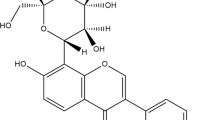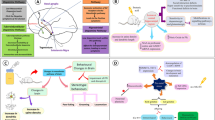Abstract
Chronic cyanide intoxication from cassava has been implicated as the cause for a degenerative neuropathy known widely as tropical ataxic neuropathy. An attempt has been made in this study to identify the specific cause for neuropathy caused by cassava using Wistar strain albino rats as the experimental animal model. The results of cassava fed animals were compared with control animals, animals given cyanide, malnourished animals and malnourished animals fed cyanide, to identify the causative factors. This study revealed that though the behavioural pattern in motor coordination of the cassava fed animals was similar to the other groups studied, the neurochemical basis for the observed behavioural pattern was unique for cassava. Hence the neurotoxicity of cassava could be attributed to unmetabolized linamarin, more than its nutritional status and/or cyanide toxicity.
Similar content being viewed by others
References
Banea, M., Tylleskar, T. and Rosling, H. (1997) Konzo and Ebola in Bandundi region.Lancet 349, 621.
Casadei, E., Cliff, T. and Neves, J. (1990) Surveillance of urinary thiocyanate concentration after epidemic spastic paraparesis in Mozambique.J. Trap. Med. Hyg. 93, 257–261.
Clark, A. (1935) On the acetidogy of pellagra and allied nutritional diseases.West. Afr. Med. J. 8, 79.
Cliff, J., Lundqvist, P., Martensson, J., Rosling, H. and Sorbo, B. (1985) Association of high cyanide and low sulphur intake in cassava-induced spastic paraparesis.Lancet 2(8466), 1211–1213.
Cruickshank, E.K. (1976) Effects of malnutrition on the central nervous system and the nerves. In:Handbook of Clinical Neurology, Vol. 28. Metabolic and Deficiency Diseases of the Nervous System, Part 2. Amsterdam, Elsevier North, pp. 1–41.
Delange, E, Bourdoux, P., Colinet, E.et al. (1982) Nutritional factors involved in the goitrogenic action of cassava. In:Cassava Toxicity and Thyroid: Research and Public Health Issues. Proceedings of a Workshop, Ottawa IDRC Monograph 207e, pp. 17–26.
Dunham, N.W. and Miya, T.S. (1975) A note on a simple apparatus for detecting neurological deficit in rats and mice.J. Am. Pharmaceutical Assoc. Sci. XIVI, 208–209.
Glowinski, J. and Iverson, L.L. (1966) Regional studies of catecholamines in the rat brain — I. The disposition of (3H) norepinephrine (3H) dopamine and (3H) dopa in various regions of the brain.J. Neurochem. 13, 655–669.
Kamalu, B.P. (1991) The effect of nutritionally-balanced cassava (Manihot esculenta Crantz) diet on endocrine function using the dog as a mode. 2.Thyroid. Br. J. Nutr. 65, 373–379.
Kanthasamy, A.G., Borowitz, J.L., Pavalkovic, G. and Isom, G.E. (1994) Dopaminergic neurotoxicity of cyanide: neurochemical, histological and behavioural characterization.Toxicol. Appl. Pharmacol. 126, 156–163.
Maduagwa, E.N. and Umoh, I.B. (1986) Biliary excretion of linamarin in the wistar rat after a single dose.Biochem. Pharmacol. 35, 13003–3006.
Maduagwa, E.N. (1989) Metabolism of linamarin in rats.Fd. Chem. Toxicol. 27, 451–454.
Mathangi, D.C., Mohan, V. and Namasivayam, A. (1999) Effect of cassava on motor coordination and neurotransmitter level in the albino rat.Fd. Chem. Toxicol. 37, 57–60.
Mathangi, D.C. and Namasivayam, A. (2000) Effect of chronic cyanide intoxication on memory in albino rats.Fd. Chem. Toxicol. 38, 51–55.
Milingi, N., Kimatta, S., Rosling, H. (1991) Konzo, a paralytic disease observed in southern Tanzania.Trop. Doct. 21, 24–25.
Ministry of Health — Mozambique. Casadei, E., Janes, P., Molin, A., Rodrigues, A. and Rosling, H. (1984b) Mantakassa: an epidemic of spastic paraparesis associated with chronic cyanide intoxication in a cassava staple area in Mozambique 2. Nutritional factors and hydrocyanide content of cassava products.Bull WHO 62, 485–492.
Money, G.L. (1959) Clinical aspects of tropical ataxic neuropathy due to malnutrition.West Afr. Med. J. 8, 3–6.
Nartey, F. (1968) Studies on cassavaManihot utilissima pohl I. Cyanogenesig: the biochemistry of linamarin and lotau-strolin in etiolated seedlings.Phytochemistry 7, 1307–1312.
Oke, O.L. (1973): The mode of cyanide detoxication. In:Chronic Cassava Toxicity. Proc. Interdisciplinary Workshop, London, IDRC 0l0e, pp. 97–104.
Osuntokun, B.O. (1971) Epidemiology of the tropical ataxic neuropathy in Nigeria.Trans. R. Soc. Trap. Med. Hyg. 65, 454–479.
Osunstokun, B.O. (1972) Chronic cyanide neurotoxicity in Nigerian plant foods.Hum. Nutr. 2, 215–260.
Osuntokun, B.O. (1981) Cassava diet, chronic cyanide intoxication and neuropathy in the Nigerian Africans.Wld. Rev. Nutr. Diet. 36, 141–173.
Persson, S. A., Cassel, G. and Sellstrom, A. (1985) Acute cyanide intoxication and central transmitter systems.Fund. Appl. Toxicol. 5, S150-S159.
Spillane, J.D. (1973) As quoted by Osuntokun (1981).
Tyllesker, T., Banea, M., Bikangi, N., Fresco, L., Persson, L.A. and Rosling, H. (1991) Epidemiological evidence from Zaire for a dietary etiology of konzo, an upper motor neuron disease.WHO Bull. OMS 69, 581–589.
Tylleskar, T., Legue, R.N., Peterson, S., Kpizinqui, E. and Stocker, P. (1994) Konzo in central African Republic.Neurology 44, 959–961.
Umoh, I.B., Ogunkoya, F.O. and Maduagwa, E.N. (1985) Effect of thiamine status on the metabolism of linamarin in rats.Ann. Nutr. Metab. 29, 319–324.
Wagner, J., Vitali, P., Palfreynman, M.G., Zraika, M. and Hout, S. (1982) Simultaneous determination of 3,4-dihydroxyphenylalanine, 5-hydroxytryptophan, dopamine, 4-hydroxy-3-ethoxyphenylalanine, norepinephrine, 3,4-dihy-droxyphenylacetic acid, homovanillic acid, serotonin and 5-hydroxy indole acetic acid in rat cerebrospinal fluid and brain by high-performance liquid chromatography with electrochemical detection.J. Neurochem. 38, 12–41.
Winkler, W.O. (1958) Reports on methods for glucosidal hydrogen cyanide in lima beans.J. Assoc. Agri. Chemist. 41, 282–287.
Wood, T. (1965) The cyanogenic glucoside content of cassava and cassava products.J. Sci. Fd. Agric. 16, 300–305.
Author information
Authors and Affiliations
Corresponding author
Rights and permissions
About this article
Cite this article
Mathangi, D.C., Namasivayam, A. Neurochemical and behavioural correlates in cassava-induced neurotoxicity in rats. neurotox res 2, 29–35 (2000). https://doi.org/10.1007/BF03033325
Received:
Revised:
Issue Date:
DOI: https://doi.org/10.1007/BF03033325




